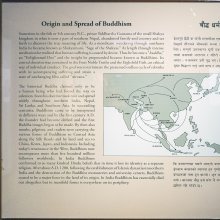Utpatti: 26 definitions
Introduction:
Utpatti means something in Hinduism, Sanskrit, Jainism, Prakrit, the history of ancient India, Marathi, Hindi. If you want to know the exact meaning, history, etymology or English translation of this term then check out the descriptions on this page. Add your comment or reference to a book if you want to contribute to this summary article.
Images (photo gallery)
In Hinduism
Purana and Itihasa (epic history)
Source: archive.org: Shiva Purana - English TranslationUtpatti (उत्पत्ति) refers to “someone’s birth”, according to the Śivapurāṇa 2.4.13 (“The birth of Gaṇeśa”).—Accordingly, as Brahmā said to Nārada: “Due to the difference of Kalpas, the story of the birth of Gaṇeśa is told in different ways. According to one account he is born of the great lord. His head looked at by Śani was cut off and an elephant’s head was put on him. Now we narrate the story of the birth (utpatti) of Gaṇeśa in Śvetakalpa when his head was cut off by the merciful Śiva. [...]”.
Utpatti has the following Synonyms: Jani.
Source: Cologne Digital Sanskrit Dictionaries: The Purana IndexUtpatti (उत्पत्ति).—Creation described.*
- * Brahmāṇḍa-purāṇa II. 19. 188-190.

The Purana (पुराण, purāṇas) refers to Sanskrit literature preserving ancient India’s vast cultural history, including historical legends, religious ceremonies, various arts and sciences. The eighteen mahapuranas total over 400,000 shlokas (metrical couplets) and date to at least several centuries BCE.
Mīmāṃsā (school of philosophy)
Source: Srimatham: Mīmāṃsa: The Study of Hindu ExegesisUtpatti (उत्पत्ति) refers to “primary injunction to perform an action”. It is one of the four classifications of vidhi (injunciton).—Utpatti-vidhi is a precept with a certain objective, which creates a desire to act, eg. “One desirous of attaining heaven should perform the agnihotra”. (a fire sacrifice)

Mimamsa (मीमांसा, mīmāṃsā) refers to one of the six orthodox Hindu schools of philosophy, emphasizing the nature of dharma and the philosophy of language. The literature in this school is also known for its in-depth study of ritual actions and social duties.
Vaishnavism (Vaishava dharma)
Source: Devotees Vaishnavas: Śrī Garga SaṃhitāUtpatti (उत्पत्ति) refers to the first of twenty-six ekādaśīs according to the Garga-saṃhitā 4.8.9. Accordingly, “to attain Lord Kṛṣṇa’s mercy you should follow the vow of fasting on ekādaśī. In that way You will make Lord Kṛṣṇa into your submissive servant. Of this there is no doubt”. A person who chants the names of these twenty-six ekādaśīs (e.g., Utpatti) attains the result of following ekādaśī for one year.

Vaishnava (वैष्णव, vaiṣṇava) or vaishnavism (vaiṣṇavism) represents a tradition of Hinduism worshipping Vishnu as the supreme Lord. Similar to the Shaktism and Shaivism traditions, Vaishnavism also developed as an individual movement, famous for its exposition of the dashavatara (‘ten avatars of Vishnu’).
Vyakarana (Sanskrit grammar)
Source: Wikisource: A dictionary of Sanskrit grammarUtpatti (उत्पत्ति).—(I) production: cf. वर्णोत्पत्तिः (varṇotpattiḥ) production of a phonetic element T. Pr. 23.1 ; (2) production of a grammatical element such as the application of an affix or addition of an augment or substitution of a letter or letters during the process of word-formation: cf. गतिकारकोपपदानां कृद्भिः सह समासवचनं प्राक् सुबुत्पत्तेः (gatikārakopapadānāṃ kṛdbhiḥ saha samāsavacanaṃ prāk subutpatteḥ) Pari. Śek. Par. 75; M. Bh. II.2.19. Vārt, 4.

Vyakarana (व्याकरण, vyākaraṇa) refers to Sanskrit grammar and represents one of the six additional sciences (vedanga) to be studied along with the Vedas. Vyakarana concerns itself with the rules of Sanskrit grammar and linguistic analysis in order to establish the correct context of words and sentences.
Ayurveda (science of life)
Source: gurumukhi.ru: Ayurveda glossary of termsUtpatti (उत्पत्ति):—[utpattiḥ] Originate or evolve

Āyurveda (आयुर्वेद, ayurveda) is a branch of Indian science dealing with medicine, herbalism, taxology, anatomy, surgery, alchemy and related topics. Traditional practice of Āyurveda in ancient India dates back to at least the first millenium BC. Literature is commonly written in Sanskrit using various poetic metres.
Shaktism (Shakta philosophy)
Source: Google Books: Manthanabhairavatantram1) Utpatti (उत्पत्ति) refers to the “creation (of the universe)”, according to the Manthānabhairavatantra.—Accordingly, “(The goddess) is the emanation (sṛṣti) of all the elements (bhūta). She creates the universe [i.e., jagadut-patti-kārikā]. Residing in the middle of the wheel (of energies) or participating in the (clockwise) rotation of the sun, she bestows worldly enjoyment. Established in the lunar nature, she bestows liberation and is called the New Moon. [...]”
2) Utpatti (उत्पत्ति) refers to the “product (of the essence of knowledge)”, according to the Ṭīkā (commentary) on the Manthānabhairavatantra, a vast sprawling work that belongs to a corpus of Tantric texts concerned with the worship of the goddess Kubjikā.—Accordingly, “[...] The three-fold transmission is said to be these three lineages. How is the three-fold transmission? (It is) the product of the essence (sadbhāva-utpatti) of knowledge because it is the product of consciousness which is the essence of true knowledge. This is the meaning. How is it that it is called the cause of the cause of the differentiation of the (three) times, namely, the future, the present and the past? [...]”..

Shakta (शाक्त, śākta) or Shaktism (śāktism) represents a tradition of Hinduism where the Goddess (Devi) is revered and worshipped. Shakta literature includes a range of scriptures, including various Agamas and Tantras, although its roots may be traced back to the Vedas.
Kavya (poetry)
Source: Brill: Śaivism and the Tantric Traditions (kavya)Utpatti (उत्पत्ति) refers to “(having) been born”, according to Kālidāsa’s Raghuvaṃśa verse 8.84.—Accordingly: “So do not think about her death. Those who have been born (utpatti-matā) will surely die. Have regard for this Earth, for the Earth is the true wife of kings”.

Kavya (काव्य, kavya) refers to Sanskrit poetry, a popular ancient Indian tradition of literature. There have been many Sanskrit poets over the ages, hailing from ancient India and beyond. This topic includes mahakavya, or ‘epic poetry’ and natya, or ‘dramatic poetry’.
Yoga (school of philosophy)
Source: ORA: Amanaska (king of all yogas): A Critical Edition and Annotated Translation by Jason BirchUtpatti (उत्पत्ति) refers to “arising”, according to the Amanaska Yoga treatise which deals absorption, yogic powers and liberation.—The Amanaska referred to (or qualified) Samādhi with several terms, which are all negative; [e.g., it is devoid of existence and non-existence, cessation and arising (vināśa-utpatti);] [...] The fact that such terminology is found in the Amanaska indicates that descriptions of Śiva and the void-like meditative states in Mantramargic Śaivism, were the basis of the descriptions of Samādhi and Paratattva (the highest reality) in this treatise. The Amanaska Yoga was consistent with the Pātañjala Yogaśāstra’s definition of Yoga, yet it described Samādhi in terms different to those of Pātañjalayoga; such as Acala—“that which is devoid of existence and non-existence, cessation and arising (vināśa-utpatti)”.

Yoga is originally considered a branch of Hindu philosophy (astika), but both ancient and modern Yoga combine the physical, mental and spiritual. Yoga teaches various physical techniques also known as āsanas (postures), used for various purposes (eg., meditation, contemplation, relaxation).
In Jainism
General definition (in Jainism)
Source: The University of Sydney: A study of the Twelve ReflectionsUtpatti (उत्पत्ति) refers to the “condition of human (birth)” [?], according to Pūjyapāda’s Sarvārthasiddhi.—Accordingly, “[...] And even among the five-sensed beings, many belong to the animal world such as the cow, the deer, the bird, the serpent, etc. Hence human birth is as difficult of attainment as a heap of jewels at the crossing of the roads. And if one loses the condition of a human being by negligence, it is as difficult to attain it (utpatti—tatpracyave ca punas tad utpattir) once again, as it is difficult for a burnt tree to regain its old freshness. Even if human birth is attained, a good country, a good family, keen senses, health, etc. are more and more difficult of attainment. [...]”.
Synonyms: Kṛti.

Jainism is an Indian religion of Dharma whose doctrine revolves around harmlessness (ahimsa) towards every living being. The two major branches (Digambara and Svetambara) of Jainism stimulate self-control (or, shramana, ‘self-reliance’) and spiritual development through a path of peace for the soul to progess to the ultimate goal.
India history and geography
Source: Cologne Digital Sanskrit Dictionaries: Indian Epigraphical GlossaryUtpatti.—(EI 12), cf. samasta-utpatti-sahita, ‘together with all the produce (or income)’. Note: utpatti is defined in the “Indian epigraphical glossary” as it can be found on ancient inscriptions commonly written in Sanskrit, Prakrit or Dravidian languages.

The history of India traces the identification of countries, villages, towns and other regions of India, as well as mythology, zoology, royal dynasties, rulers, tribes, local festivities and traditions and regional languages. Ancient India enjoyed religious freedom and encourages the path of Dharma, a concept common to Buddhism, Hinduism, and Jainism.
Languages of India and abroad
Marathi-English dictionary
Source: DDSA: The Molesworth Marathi and English Dictionaryutpatti (उत्पत्ति).—f (S) Birth or production; proceeding or issuing from; coming forth. utpatti, sthiti, laya or saṃhāra Birth, life, and death; production, existence, and destruction. The three predicables of every creature, and referred respectively, as their patron-deities, to brahmā, viṣṇu, śiva.
Source: DDSA: The Aryabhusan school dictionary, Marathi-Englishutpatti (उत्पत्ति).—f Birth or production. Origin.
Marathi is an Indo-European language having over 70 million native speakers people in (predominantly) Maharashtra India. Marathi, like many other Indo-Aryan languages, evolved from early forms of Prakrit, which itself is a subset of Sanskrit, one of the most ancient languages of the world.
Sanskrit dictionary
Source: DDSA: The practical Sanskrit-English dictionaryUtpatti (उत्पत्ति).—f.
1) Birth; विपदुत्पत्तिमतामुपस्थिता (vipadutpattimatāmupasthitā) R.8.83.
2) Production; कुसुमे कुसुमोत्पत्तिः श्रूयते न तु दृश्यते (kusume kusumotpattiḥ śrūyate na tu dṛśyate) Ś. Til.17.
3) Source, origin; उत्पत्तिः साधुतायाः (utpattiḥ sādhutāyāḥ) K.45.
4) Rising, going up, becoming visible, coming into existence.
5) Profit, productiveness, produce; स्वल्पोत्पत्तिदेशः (svalpotpattideśaḥ) Rāj T.5.68.
6) Producing as a result or effect.
7) Resurrection.
8) A sacrifice; उत्पत्तिरिति यजिं ब्रूमः (utpattiriti yajiṃ brūmaḥ) | ŚB. on MS.7.1.3,7.
9) An original injunction, a scriptural text enjoining (a particular matter), also called उत्पत्तिश्रुति (utpattiśruti) or उत्पत्तिविधि (utpattividhi). उत्पत्तेश्चातत्प्रधानत्वात् (utpatteścātatpradhānatvāt) | Manusmṛti 4.3.
Derivable forms: utpattiḥ (उत्पत्तिः).
Source: Cologne Digital Sanskrit Dictionaries: Edgerton Buddhist Hybrid Sanskrit DictionaryUtpatti (उत्पत्ति).—f. (= Pali uppatti, see especially aṭṭhuppatti, Critical Pali Dictionary; compare Sanskrit utpatti in [Boehtlingk], 4), orig. occurrence, and so occasion: asyām utpattau Mahāvyutpatti 9209, on this occasion, see nidāna 6.
Source: Cologne Digital Sanskrit Dictionaries: Shabda-Sagara Sanskrit-English DictionaryUtpatti (उत्पत्ति).—f.
(-ttiḥ) 1. Birth, production. 2. Producing as an effect or result, giving rise to or generating as a consequence. 3. Production in general. E. ut up, pat to go, and ktin aff.
Source: Cologne Digital Sanskrit Dictionaries: Benfey Sanskrit-English DictionaryUtpatti (उत्पत्ति).—i. e. ud-pad + ti, f. 1. Springing up, [Śṛṅgāratilaks] 20. 2. Birth, [Mānavadharmaśāstra] 3, 16; second birth, 2, 68. 3. Produce, [Rājataraṅgiṇī] 5, 69.
Source: Cologne Digital Sanskrit Dictionaries: Cappeller Sanskrit-English DictionaryUtpatti (उत्पत्ति).—[feminine] coming forth, origin, birth (p. nant); result, produce.
Source: Cologne Digital Sanskrit Dictionaries: Monier-Williams Sanskrit-English Dictionary1) Utpatti (उत्पत्ति):—[=ut-patti] [from ut-pad] f. arising, birth, production, origin, [Suśruta; Mahābhārata; Yājñavalkya] etc.
2) [v.s. ...] resurrection, [Manu-smṛti]
3) [v.s. ...] production in general, profit, productiveness, [Rājataraṅgiṇī]
4) [v.s. ...] producing as an effect or result, giving rise to, generating as a consequence
5) [v.s. ...] occurrence, the being mentioned or quoted (as a Vedic passage), [Jaimini]
Source: Cologne Digital Sanskrit Dictionaries: Yates Sanskrit-English DictionaryUtpatti (उत्पत्ति):—[utpa+tti] (ttiḥ) 2. f. Birth, production.
Source: DDSA: Paia-sadda-mahannavo; a comprehensive Prakrit Hindi dictionary (S)Utpatti (उत्पत्ति) in the Sanskrit language is related to the Prakrit word: Uppatti.
[Sanskrit to German]
Sanskrit, also spelled संस्कृतम् (saṃskṛtam), is an ancient language of India commonly seen as the grandmother of the Indo-European language family (even English!). Closely allied with Prakrit and Pali, Sanskrit is more exhaustive in both grammar and terms and has the most extensive collection of literature in the world, greatly surpassing its sister-languages Greek and Latin.
Hindi dictionary
Source: DDSA: A practical Hindi-English dictionaryUtpatti (उत्पत्ति):—(nf) production, produce; birth; origin.
...
Kannada-English dictionary
Source: Alar: Kannada-English corpusUtpatti (ಉತ್ಪತ್ತಿ):—
1) [noun] birth a) the act or fact of coming into life or of being born; b) the act of bringing forth an offspring.
2) [noun] that in which something has its beginning; a source; a prime cause; an origin.
3) [noun] something produced; yield; produce.
Kannada is a Dravidian language (as opposed to the Indo-European language family) mainly spoken in the southwestern region of India.
See also (Relevant definitions)
Starts with (+6): Utpatti-shastra, Utpattidhaman, Utpattika, Utpattikala, Utpattikalavacchinnatva, Utpattikalina, Utpattikara, Utpattiketana, Utpattikrama, Utpattimant, Utpattimat, Utpattinamadheyatva, Utpattinasha, Utpattiprakarana, Utpattiprayoga, Utpattisadhana, Utpattishishta, Utpattisthana, Utpattitantra, Utpattivada.
Ends with (+21): Amatyotpatti, Amritakundalyutpatti, Anutpatti, Arthotpatti, Ashtapadatirthotpatti, Ashvavakebodhatirthotpatti, Avyutpatti, Chattravyutpatti, Chyutyutpatti, Cyutyutpatti, Dhatutpatti, Draupadyutpatti, Gandhasamutpatti, Ganeshotpatti, Garbhotpatti, Guhotpatti, Jagatutpatti, Mahavyutpatti, Mantrotpatti, Nashotpatti.
Full-text (+104): Utpattivyanjaka, Anutpatti, Autpattika, Utpattiprayoga, Utpattikalina, Utpattishishta, Utpattikalavacchinnatva, Utpattivakya, Utpattikrama, Utpattividhi, Utpattimant, Utpattiprakarana, Utpattiketana, Utpattidhaman, Utpattimat, Utpattikala, Punarutpatti, Puttirorpatti, Rasotpatti, Uppatti.
Relevant text
Search found 48 books and stories containing Utpatti, Ut-patti; (plurals include: Utpattis, pattis). You can also click to the full overview containing English textual excerpts. Below are direct links for the most relevant articles:
Bhakti-rasamrta-sindhu (by Śrīla Rūpa Gosvāmī)
Verse 2.4.232 < [Part 4 - Transient Ecstatic Disturbances (vyābhicāri-bhāva)]
Garga Samhita (English) (by Danavir Goswami)
Verse 4.8.13 < [Chapter 8 - In the Story of the Yajña-sītās, the Glories of Ekādaśī]
Verse 2.2.2 < [Chapter 2 - Description of Girirāja Govardhana’s Birth]
Verse 3.5.7 < [Chapter 5 - The Dispute Among the Gopas]
Rig Veda (translation and commentary) (by H. H. Wilson)
The Tattvasangraha [with commentary] (by Ganganatha Jha)
Verse 1127-1130 < [Chapter 16 - Examination of the Import of Words]
Yoga Vasistha [English], Volume 1-4 (by Vihari-Lala Mitra)
Book III - Utpatti khanda (utpatti khanda)
Chapter CXX - Continuation of the same: on the seven stages of edification < [Book VI - Nirvana prakarana part 1 (nirvana prakarana)]
Vakyapadiya of Bhartrihari (by K. A. Subramania Iyer)
Verse 3.13.27 < [Book 3 - Pada-kāṇḍa (13): Liṅga-samuddeśa (On Gender)]
Verse 3.7.128 < [Book 3 - Pada-kāṇḍa (7): Sādhana-samuddeśa (On the Means)]
Verse 1.55 < [Book 1 - Brahma-kāṇḍa (or Āgama-samuccaya)]
Related products



